
Content - Richard Lundström
Layout - Sebastian Bianchi
World War Two
Second World War German ribbon bars are quite limited, compared to the vast array of possible Imperial combinations. Most of the awards established from 1939 to 1945 were not worn on ribbons. As a result, a German without any pre-war awards was unlikely to have a ribbon bar longer than 3 or at most 4 awards. Since three of the new ribboned awards: the 1939 version of the Iron Cross 2nd Class, the War Merit Crosses 2nd Class, and the 1941/42 Russian campaign medal, were frequently worn from the second buttonhole of tunics, that reduced even further the size and variety of ribbon bars.
These are typical WW2 ribbon bars: Obverses;
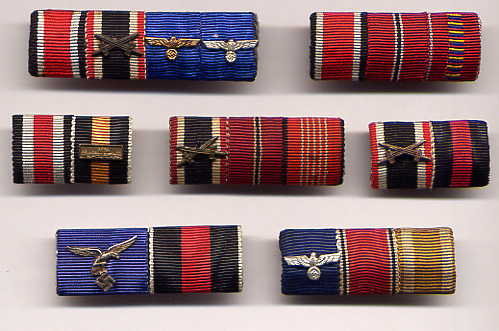
Reverses;
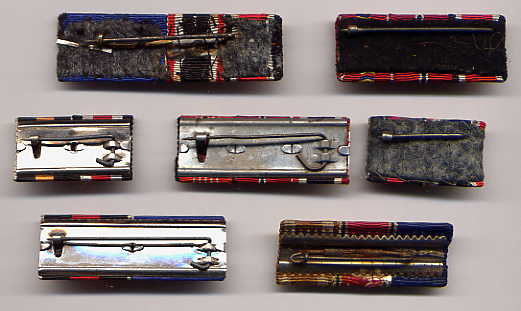
Most wartime backings will be made of scraps of uniform or insignia backing colored material. An early war variation of the new 1939 Iron Cross second class ribbon is distinctive for its out of proportion wide white and black edges-here compared with the normal version.
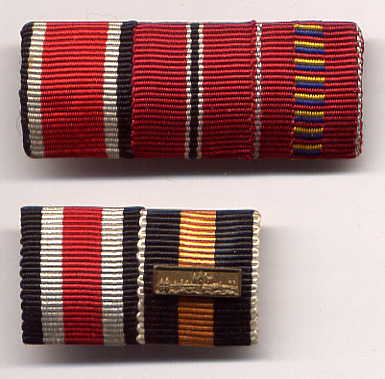
The ribbon manufacturer responsible for this inaccuracy may be ultimately identifiable. Full size medal bars, typically hook back south German style for showy "semi dress" circa 1940 also can be found with wider edges than normal.
Members of the uniformed services outside the Wehrmacht continued to wear their old Imperial military long service awards with their new Third Reich service awards
|
|
| This policeman wore a scarce device for the Prussian XII Years Service Medal on what would otherwise be a multiple-awards plain blue ribbon-compare with illustration 47. BO |
Holders of Imperial long service awards called back into WEHRMACHT service were required to replace them with corresponding grade(s) of the "new Wehrmacht" awards-so that ribbon bars may be found with a Wehrmacht 12, Wehrmacht 4, and something like the Third Reich 25 Years Civil Service Cross-that was entirely proper by regulations.
These five bars below from about 1942 illustrate the regulation placement of the War Merit Cross 2nd Class and 1941/42 "East Medal"-illogical and peculiar looking as they are.
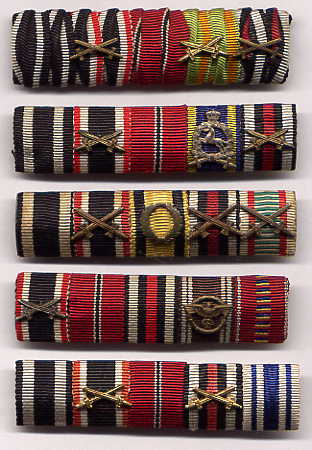
Note the transition from solid struck swords devices with the triangle between the hilts and blades cut out, and the final type of hollow stamped swords not cut out.
The top ribbon bar places the two WW2 awards ahead of a WWI Baden Order of the Zähringen Lion-Knight with Swords. On the second bar these two precede a Brunswick Ernst August Cross 2nd Class with the ornate device for a minimum of two years service at the front! The middle bar places the so-called "Sitzfleischorden" ahead of the Military Merit Order, Württemberg's highest valor decoration for officers in the First World War. The relative merits of these may be judged from the fact that the MMO was bestowed 2,183 times, while approximately 6 million KVK2Xs were handed out in WW2!
More often than not, the ridiculous precedence of these two lowly WW2 awards was altered by recipients, who rightly placed WW1 valor decorations before the often rear area desk job KVK2X. (I knew a Luftwaffe Flak Oberleutnant dR who led a sheltered life in a "cushy" job 1939-44 who told me he was actually embarrassed going to the front with nothing but that ribbon, since it marked him as a "shirker"-though he soon earned two Iron Crosses and a Ground Assault Badge as an anti-tank officer in the final year of the war.) Indeed, in some cases the KVK may even be found mounted after the Hindenburg Cross with Swords. Placement of the East Medal for mere weeks of service in an ongoing campaign as opposed to the WWI Hindenburg Crosses for an entire war led some holders to reverse precedence, though not often. It was established German custom, contrary to practice in all other nations, to generally position any such campaign and war medals in most recent first order. (See Regulations Section near the end of this article.) Note the backings here, at the early midpoint of the war.
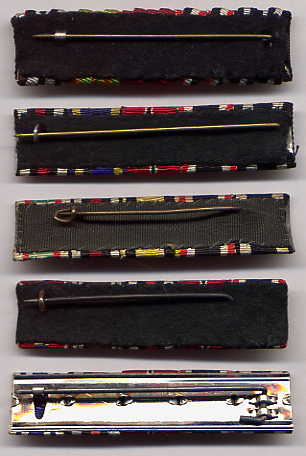
With the two bars below we see more variations in interpretation of precedence regulations.
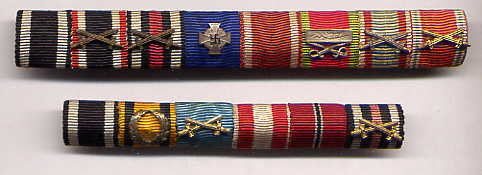
The upper bar was worn by a WWI veteran, a Third Reich civil servant, whose Turkish bravery decorations are worn in reverse seniority, following a narrow reading of the requirement that such awards be worn in the order they were received-and also possibly mistaking the lowly Turkish War Medal (a splendid red enameled star) as more prestigious than the undersized but higher Silver Liakat Medal with Sabers Bar. The lower bar, in the half height style, belonged to another highly decorated Württemberg officer, who may have dodged the unpopular KVK with Swords placement by wearing that ribbon from his buttonhole and only mounting the East Medal here-note behind his WWI decorations in the "normal" violation of regulations.

This career officer or senior NCO, another fan of the less common half height style, did not have to worry about personal value of WW1 awards versus regulations-he had only a combatant's Hindenburg Cross for combat in the last days of the First World War. All the rest of these awards are from the Third Reich, showing continuous service from about 1918. The combination of a frontline Iron Cross, the KVK2X, and Westwall Medal suggest he may have been an engineer officer, whose duties ranged from construction to pioneer assaults, or perhaps an artillery officer. Note the Rumanian Crusade Against Communism Medal in last place. This is frequently found in German groups without the 1941/42 East Medal.
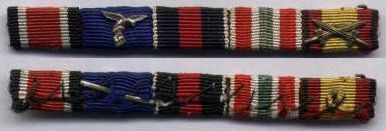
JC
The half height bar above, like the sew-on bar here is less commonly encountered than the universal 18 mm high, 15 mm wide type first authorized in 1915. This Luftwaffe officer's all Third Reich combination (EK2 1939, 4 Years Service, Sudeten, Memel, and Spanish 1936-39 Campaign Medals) shows about as many ribbons as can normally be encountered for men too young to have served in the First World War.

By contrast, this Second World War officer; with yet another half height sew-on, had more ribbons from Axis allies than his own Reich! After his Sudeten Medal there are: a Japanese Order of the Sacred Treasure, two Rumanian Orders on their "war" ribbon, an Order of the Lion of Finland with Swords, and a Finnish Order of the Cross of Liberty 2nd Class military ribbon with device indicating two awards of the same grade. Indeed, though a young officer of Captain or Major rank, this unusual Axis array may eventually help put a name back on this still anonymous ribbon bar's original wearer.

|
|
A group like this is far easier to research. Senior officers left a "paper trail" through inter-war annual Reichswehr Rank Lists that allow officers who had unbroken service to be picked out if their combinations of awards was unique, as this one and the next two examples will show. This double row of half height ribbon bars belonged to Luftwaffe Generalstabsarzt (medical Lieutenant-General) Professor Dr. med. et Dr, phil. Ernst Koschel (1875-1961). As a medical major in WWI, he had been Chief Medical Officer of the German Air Service-training as an observer himself. Demobilized in 1920, he practiced internal medicine and specialized in nervous disorders in Berlin, also consulting for Lufthansa. Returning to military service when the Air Force was created in 1935, from then until his retirement in 1944 he served as CMO of the Air Crew Examination Facility in Berlin. Although NOT a Reichsheer officer, it has still been possible to trace his service and identify him through his awards via the late Neal O'Connor's outstanding series of volumes on WWI German aviation awards, Karl Friedrich Hildebrand's essential biographical series "Die Generale der deutschen Luftwaffe 1935-1945," and the invaluable WWI award rolls being published in Germany by Michael Autengruber. Ribbon bars were worn by real people, so when it IS possible to restore a name to an original holder, research really pays off. This particular group was "rescued" in Massachusetts in October 2000 from a Midwestern dealer who picked it up as a neglected remnant of Dr. Koschel's entire group, dispersed at that September's Max Show. Koschel's name had already been "lost in retail" when I bought these ribbons-if the two rows had been divided, no identification would ever have been possible.
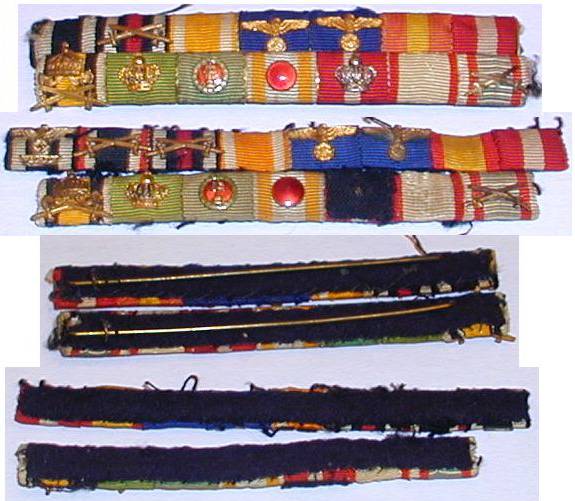
This splendid group belonged to another traceable recipient, Vizeadmiral zur See Joachim Lietzmann (1894-1959). Beyond the row of foreign awards from Spain, Bulgaria, Sweden, Hungary, Japan, and Italy, worn "Kleindekoration" style as ribbons to indicate pinback and Commander grade neck Orders, having two complete sets dating from different periods helps show how one officer's awards could change over time. Of particular note is the fact that his Order of the Crown of Italy ribbon (bottom row, third from end) has been neatly covered over, following Italy's defection to the Allies in 1943!
Young Leutnant zS Lietzmann broke out of Chinese waters with Graf von Spee's East Asia Squadron in 1914, headed across the globe for Germany. A participant in the victory of Coronel off the west coast of South America, he was one of the few survivors of the cruiser "Gneisenau," sunk off the Falkland Islands in December 1914. After internment for most of the war, he resumed a career in the Reichsmarine. In 1936/37 he was German Naval Attaché in Paris for France, Portugal, and Spain. From August 1937 until March 1940 he was Naval Attaché in Tokyo. He ended the war as German Naval Commander, Adriatic, receiving the German Cross in Gold 6 January 1945. In this case, identification was made easy by most of Admiral Lietzmann's "Nachlass" being sold by Detlev Niemann in early 2002, accompanied by documents, photos and so on. Rank Lists confirmed his Iron Crosses and Lifesaving Medal (in post 1935 precedence behind the Hindenburg Cross), and Hildebrand's and Henriot's "Deutschlands Admirale 1849-1945" filled in the gaps in his service record.

RV
This "anonymous" bar required much deeper rooting to put a name to its owner. The fourth and sixth ribbons seemed to guarantee that this officer was a Saxon- yet a Saxon native SHOULD have worn the latter ribbon (Civil Merit Order with Swords) ahead of the former (Albert Order with Swords), with the intervening Baden Order of the Zähringen Lion with swords after both. The KVK2X and East Medal are in their bizarre regulation positions. Wehrmacht double awards indicating 25 years or more of career service suggested Reichsheer Lists as an obvious place to start, while the Baden Order almost guaranteed (from the few dozen awards made to Saxons) that the owner had served in Infantry Regiment 103.
My search of the annual Reichsheer lists turned up no match, suggesting an inter-war career in the Schutzpolizei before return to the expanding Wehrmacht in the mid 1930s. Michael Autengruber's Baden awards roll volume was then consulted, and every single Saxon recipient of the OZL checked for matching Wehrmacht service. One-- and only one-name came up. Cross checking with Rick Versailles, who has the Autengruber Saxon rolls volumes, and Bernhard Holst, who has the army generals' Hildebrand biographies, not only confirmed my identification, but showed the recipient's portrait photo wearing this EXACT ribbon bar, identifiable by its unique features. The bar is slightly smaller than normal 18 mm height, all the swords are wide square "X" style rather than the usual flattened horizontal type, and though dating 1942+, uses the large "fat" style Wehrmacht long service eagles that fell out of fashion for the sleeker style early in the war.
This bar belonged to Generalmajor Johannes Hahn (1889-1970), who went from Saxon Infantry Regiment 103 to a WW1 war unit, then into the Dresden and Chemnitz SchuPo, returning (as did the bulk of German police personnel) in 1935. He served as commander of Security Regiment 602 in Russia, earning a bar to his Iron Cross 2nd Class (shown in his portrait being properly worn from the buttonhole only and not repeated on this ribbon bar). He was then a Feldkommandantur chief in Lyon and Pau, ending the war in Carinthia.
Reference sources, experience, a network of fellow specialized researchers- and some luck-can make such identifications possible.

Not every ribbon bar CAN be traced. Indeed, most can NOT be. The one above, for example, could have belonged to any of a dozen career officers from Mecklenburg. Note the rather awkwardly proportioned early style Spange.

Here is a more dramatic sized Spange, again to an unidentifiable officer. The Wehrmacht 12 and 4 years service awards here indicate that this highly decorated junior WWI officer was recalled as an (E) officer when the Wehrmacht began re-expanding, his old Imperial army time being added to that in the new armed forces.
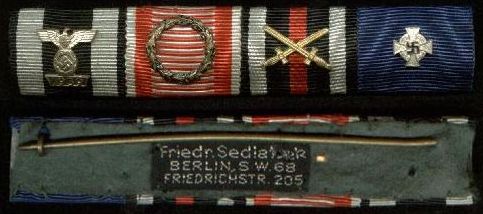
Here is another variation of a Spange device, in this case belonging to a civil servant/reserve officer called back up for WW2. The outfitter's tag is uncommon, even on full sized medal bars. Although the Sedlatzek firm acquired a blackened reputation for peddling "replicas" after the war, they were an established, legitimate company manufacturing awards as well as doing this sort of small custom military effects tailoring.

TP
Additional varieties of Spangen devices will be shown in the section devoted to 500x close-ups. This last one here shows a Schwarzburger with Westwall duty and a plain blue long service ribbon that could be any of ELEVEN awards (6 old Prussian/Reichs, 2 R.A.D., 1 Polizei, and 2 SS-VT/TKV). Without a distinguishing device, we will never know exactly which award was represented, since the Schwarzburg ribbon with swords could represent either those two tiny states' Honor Crosses for officers or Medal for enlisted ranks in World War One. Most likely he was in a frontline R.A.D. "pioneer" unit attached to the army.

JCJ
This ribbon bar also shows the "generic" blue long service ribbon, but since these awards are all Third Reich, the 6 Imperial ones can be excluded. A KVK2X, 1941/42 East Medal, and Sudeten/Bohemian 1938/39 service could be Reichs Labor Service, Police, or career Waffen-SS or career SS-Totenkopf Units. We can never know, now.

JCJ
Several possibilities also exist for the identity and career of this bar's original wearer. The Iron Cross and East Medal suggest a frontline combatant. The two NSDAP long service awards (usually, as here, embellished with redundant devices actually unnecessary because each grade had a distinct ribbon) could have belonged to any career uniformed Nazi Party organization member (see the Portrait Photos Gallery following sections on ribbon bars and devices), but the Austrian Anschluss and Sudeten Annexation with Prague bar suggest that the wearer here was, in fact, a member of the Waffen-SS. Period photographs of similar bars reveal that the typical wearer of such a bar was frequently an Allgemeine SS man serving with reserve rank in the Waffen-SS during the war. Because Nazi Party "seniority" had no direct link with rank, this man could have been a junior NCO, or a senior officer.
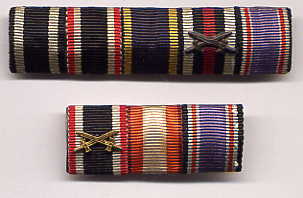
Closing out this section, it should be remembered that hundreds of thousands served in uniform at home, on civil defense and fire fighting duties, air raid wardens, emergency reserve police, technical services crews, and so on. Here are several representative samples of civil defense groups, mostly overage WW1 veterans, but in the case of the three ribbon bar, that of a well decorated fire fighter, who may have seen more danger and "action" than some soldiers.
![]()
© Copyright Wehrmacht-Awards.com LLC |
